Organizational Behavior and Leadership
VerifiedAdded on 2020/10/22
|17
|4917
|106
AI Summary
This assignment delves into various topics related to organisational behaviour and leadership, including motivation, teamwork, communication, and performance management. It draws from a range of sources such as academic papers, books, and online resources to provide a well-rounded understanding of these concepts. The assignment is designed to test students' knowledge and critical thinking skills in applying theoretical frameworks to real-world scenarios.
Contribute Materials
Your contribution can guide someone’s learning journey. Share your
documents today.
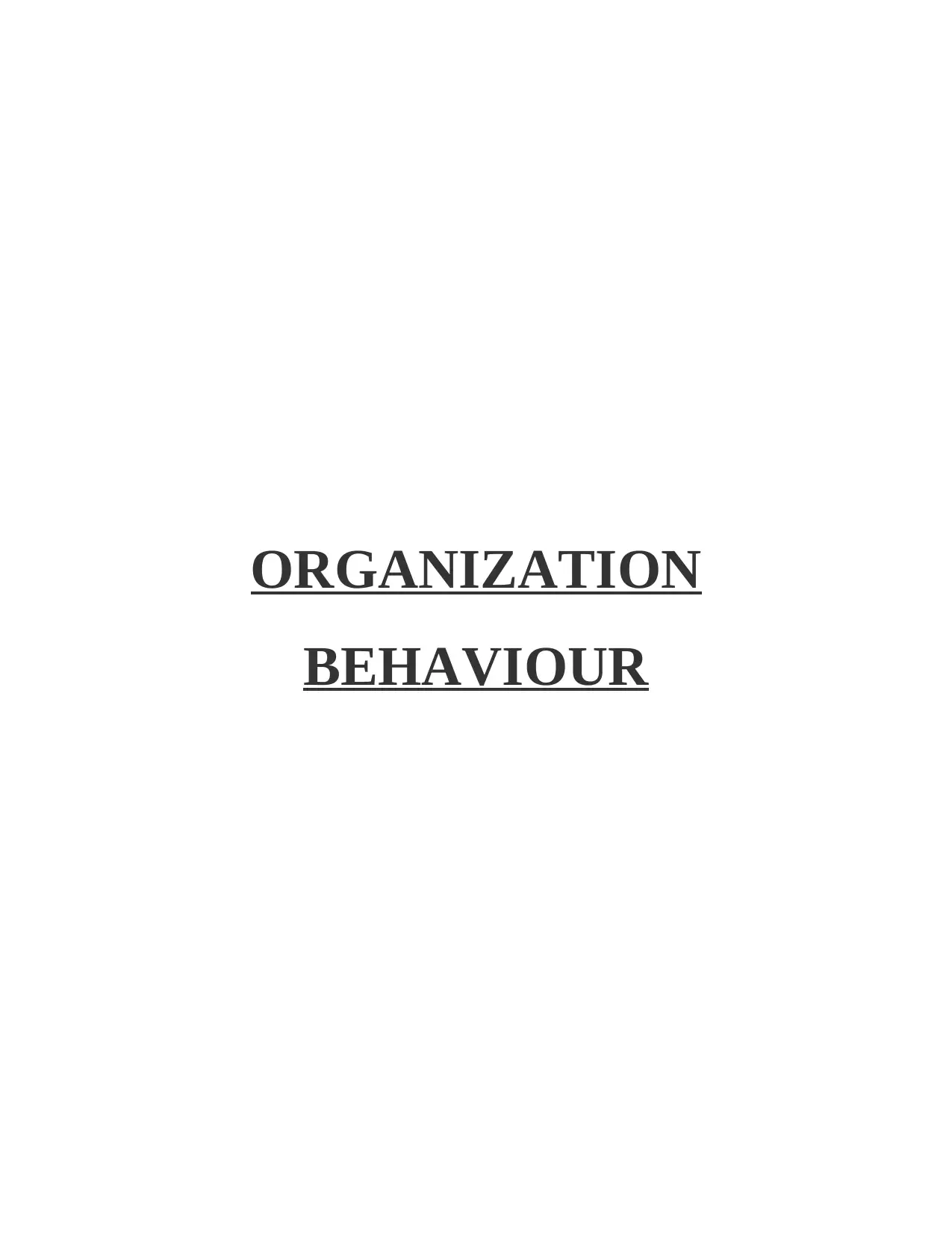
ORGANIZATION
BEHAVIOUR
BEHAVIOUR
Secure Best Marks with AI Grader
Need help grading? Try our AI Grader for instant feedback on your assignments.
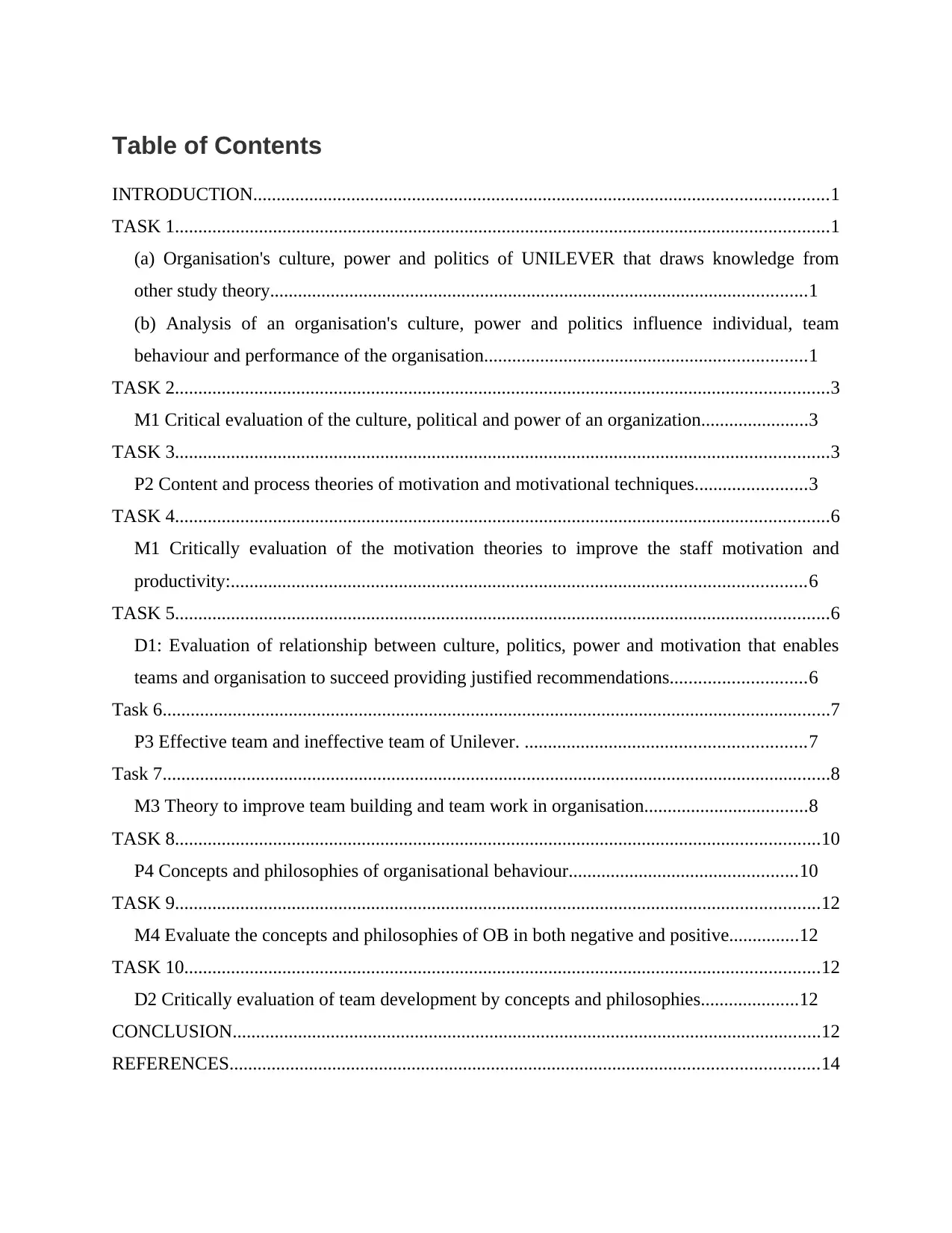
Table of Contents
INTRODUCTION...........................................................................................................................1
TASK 1............................................................................................................................................1
(a) Organisation's culture, power and politics of UNILEVER that draws knowledge from
other study theory...................................................................................................................1
(b) Analysis of an organisation's culture, power and politics influence individual, team
behaviour and performance of the organisation.....................................................................1
TASK 2............................................................................................................................................3
M1 Critical evaluation of the culture, political and power of an organization.......................3
TASK 3............................................................................................................................................3
P2 Content and process theories of motivation and motivational techniques........................3
TASK 4............................................................................................................................................6
M1 Critically evaluation of the motivation theories to improve the staff motivation and
productivity:...........................................................................................................................6
TASK 5............................................................................................................................................6
D1: Evaluation of relationship between culture, politics, power and motivation that enables
teams and organisation to succeed providing justified recommendations.............................6
Task 6...............................................................................................................................................7
P3 Effective team and ineffective team of Unilever. ............................................................7
Task 7...............................................................................................................................................8
M3 Theory to improve team building and team work in organisation...................................8
TASK 8..........................................................................................................................................10
P4 Concepts and philosophies of organisational behaviour.................................................10
TASK 9..........................................................................................................................................12
M4 Evaluate the concepts and philosophies of OB in both negative and positive...............12
TASK 10........................................................................................................................................12
D2 Critically evaluation of team development by concepts and philosophies.....................12
CONCLUSION..............................................................................................................................12
REFERENCES..............................................................................................................................14
INTRODUCTION...........................................................................................................................1
TASK 1............................................................................................................................................1
(a) Organisation's culture, power and politics of UNILEVER that draws knowledge from
other study theory...................................................................................................................1
(b) Analysis of an organisation's culture, power and politics influence individual, team
behaviour and performance of the organisation.....................................................................1
TASK 2............................................................................................................................................3
M1 Critical evaluation of the culture, political and power of an organization.......................3
TASK 3............................................................................................................................................3
P2 Content and process theories of motivation and motivational techniques........................3
TASK 4............................................................................................................................................6
M1 Critically evaluation of the motivation theories to improve the staff motivation and
productivity:...........................................................................................................................6
TASK 5............................................................................................................................................6
D1: Evaluation of relationship between culture, politics, power and motivation that enables
teams and organisation to succeed providing justified recommendations.............................6
Task 6...............................................................................................................................................7
P3 Effective team and ineffective team of Unilever. ............................................................7
Task 7...............................................................................................................................................8
M3 Theory to improve team building and team work in organisation...................................8
TASK 8..........................................................................................................................................10
P4 Concepts and philosophies of organisational behaviour.................................................10
TASK 9..........................................................................................................................................12
M4 Evaluate the concepts and philosophies of OB in both negative and positive...............12
TASK 10........................................................................................................................................12
D2 Critically evaluation of team development by concepts and philosophies.....................12
CONCLUSION..............................................................................................................................12
REFERENCES..............................................................................................................................14
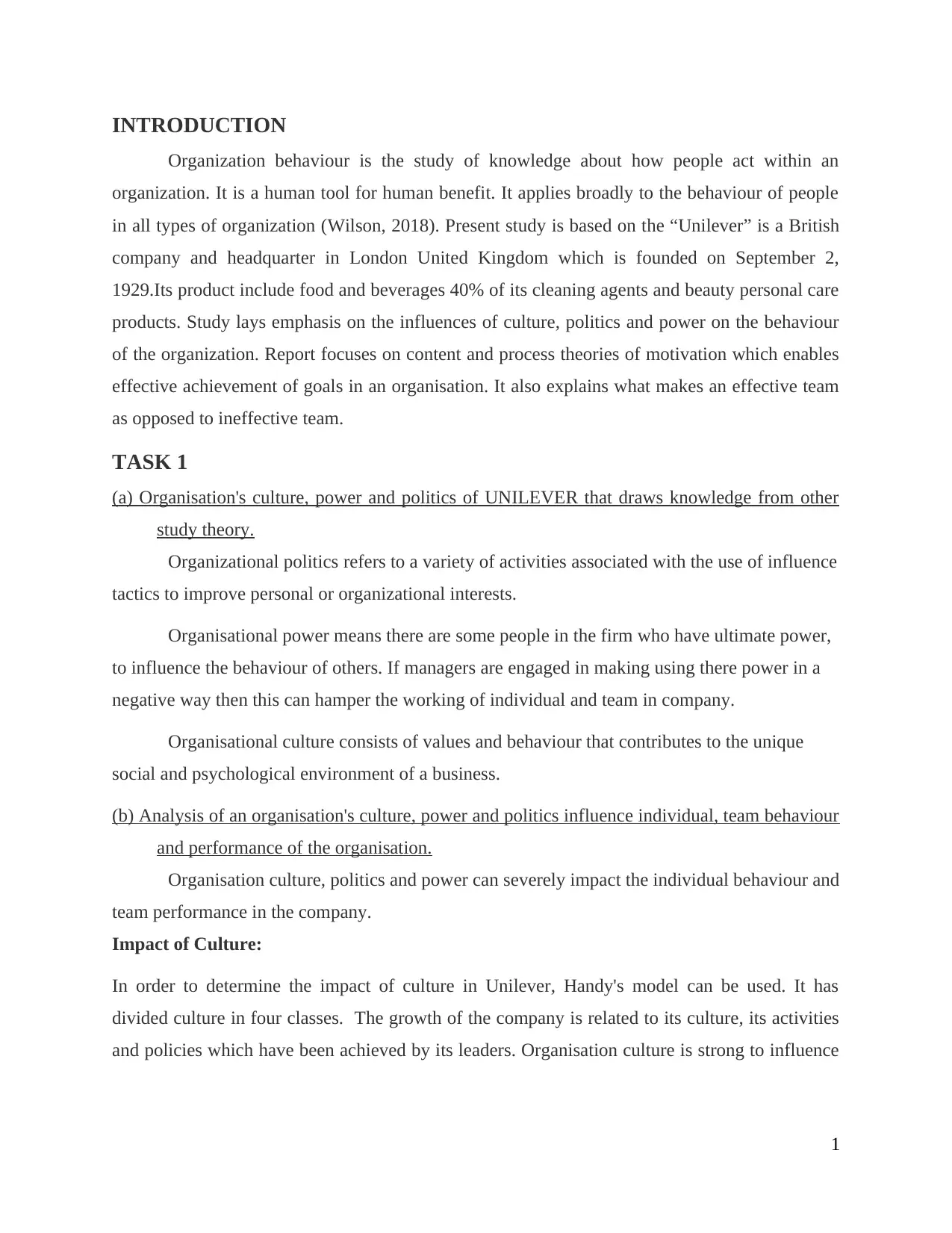
INTRODUCTION
Organization behaviour is the study of knowledge about how people act within an
organization. It is a human tool for human benefit. It applies broadly to the behaviour of people
in all types of organization (Wilson, 2018). Present study is based on the “Unilever” is a British
company and headquarter in London United Kingdom which is founded on September 2,
1929.Its product include food and beverages 40% of its cleaning agents and beauty personal care
products. Study lays emphasis on the influences of culture, politics and power on the behaviour
of the organization. Report focuses on content and process theories of motivation which enables
effective achievement of goals in an organisation. It also explains what makes an effective team
as opposed to ineffective team.
TASK 1
(a) Organisation's culture, power and politics of UNILEVER that draws knowledge from other
study theory.
Organizational politics refers to a variety of activities associated with the use of influence
tactics to improve personal or organizational interests.
Organisational power means there are some people in the firm who have ultimate power,
to influence the behaviour of others. If managers are engaged in making using there power in a
negative way then this can hamper the working of individual and team in company.
Organisational culture consists of values and behaviour that contributes to the unique
social and psychological environment of a business.
(b) Analysis of an organisation's culture, power and politics influence individual, team behaviour
and performance of the organisation.
Organisation culture, politics and power can severely impact the individual behaviour and
team performance in the company.
Impact of Culture:
In order to determine the impact of culture in Unilever, Handy's model can be used. It has
divided culture in four classes. The growth of the company is related to its culture, its activities
and policies which have been achieved by its leaders. Organisation culture is strong to influence
1
Organization behaviour is the study of knowledge about how people act within an
organization. It is a human tool for human benefit. It applies broadly to the behaviour of people
in all types of organization (Wilson, 2018). Present study is based on the “Unilever” is a British
company and headquarter in London United Kingdom which is founded on September 2,
1929.Its product include food and beverages 40% of its cleaning agents and beauty personal care
products. Study lays emphasis on the influences of culture, politics and power on the behaviour
of the organization. Report focuses on content and process theories of motivation which enables
effective achievement of goals in an organisation. It also explains what makes an effective team
as opposed to ineffective team.
TASK 1
(a) Organisation's culture, power and politics of UNILEVER that draws knowledge from other
study theory.
Organizational politics refers to a variety of activities associated with the use of influence
tactics to improve personal or organizational interests.
Organisational power means there are some people in the firm who have ultimate power,
to influence the behaviour of others. If managers are engaged in making using there power in a
negative way then this can hamper the working of individual and team in company.
Organisational culture consists of values and behaviour that contributes to the unique
social and psychological environment of a business.
(b) Analysis of an organisation's culture, power and politics influence individual, team behaviour
and performance of the organisation.
Organisation culture, politics and power can severely impact the individual behaviour and
team performance in the company.
Impact of Culture:
In order to determine the impact of culture in Unilever, Handy's model can be used. It has
divided culture in four classes. The growth of the company is related to its culture, its activities
and policies which have been achieved by its leaders. Organisation culture is strong to influence
1
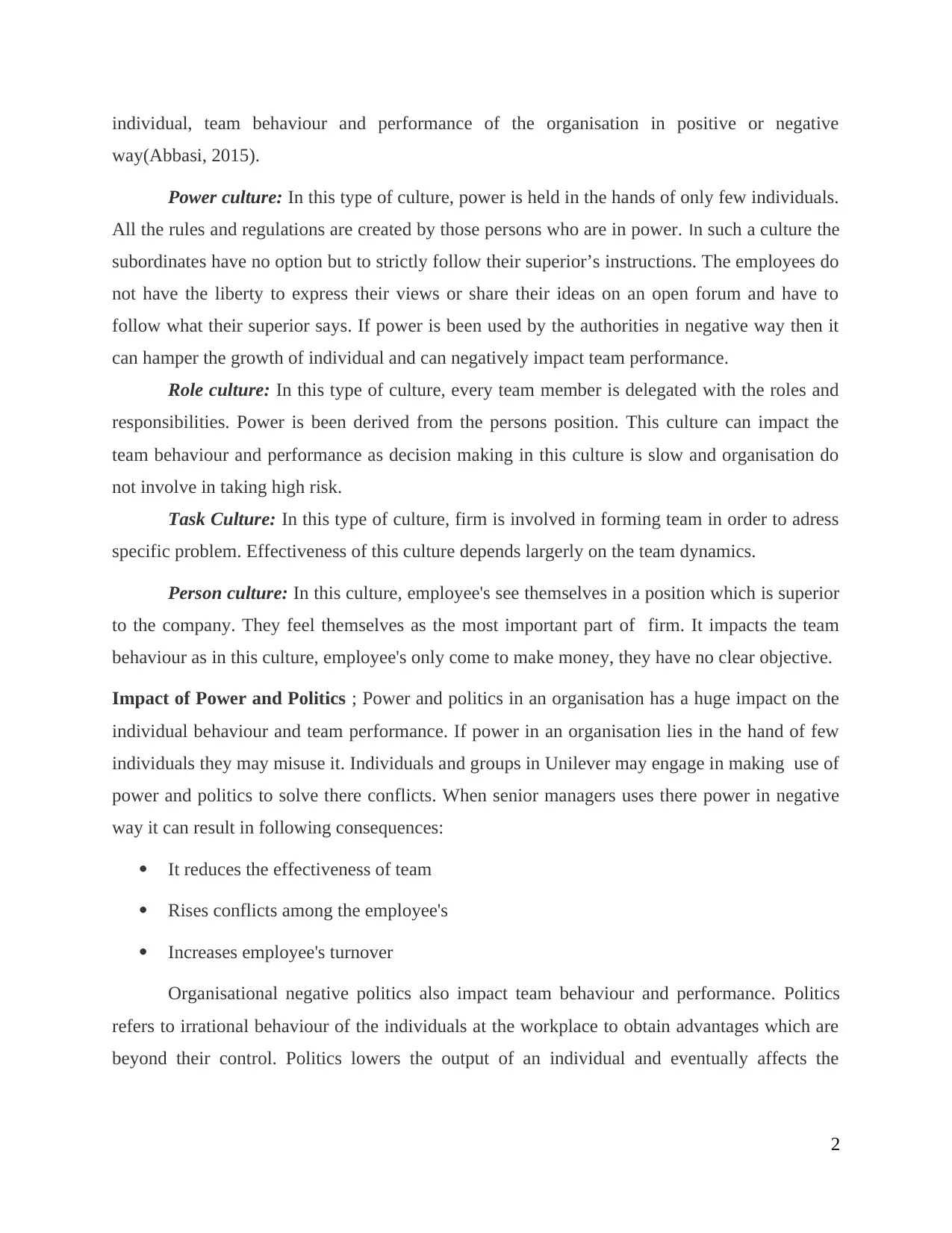
individual, team behaviour and performance of the organisation in positive or negative
way(Abbasi, 2015).
Power culture: In this type of culture, power is held in the hands of only few individuals.
All the rules and regulations are created by those persons who are in power. In such a culture the
subordinates have no option but to strictly follow their superior’s instructions. The employees do
not have the liberty to express their views or share their ideas on an open forum and have to
follow what their superior says. If power is been used by the authorities in negative way then it
can hamper the growth of individual and can negatively impact team performance.
Role culture: In this type of culture, every team member is delegated with the roles and
responsibilities. Power is been derived from the persons position. This culture can impact the
team behaviour and performance as decision making in this culture is slow and organisation do
not involve in taking high risk.
Task Culture: In this type of culture, firm is involved in forming team in order to adress
specific problem. Effectiveness of this culture depends largerly on the team dynamics.
Person culture: In this culture, employee's see themselves in a position which is superior
to the company. They feel themselves as the most important part of firm. It impacts the team
behaviour as in this culture, employee's only come to make money, they have no clear objective.
Impact of Power and Politics ; Power and politics in an organisation has a huge impact on the
individual behaviour and team performance. If power in an organisation lies in the hand of few
individuals they may misuse it. Individuals and groups in Unilever may engage in making use of
power and politics to solve there conflicts. When senior managers uses there power in negative
way it can result in following consequences:
It reduces the effectiveness of team
Rises conflicts among the employee's
Increases employee's turnover
Organisational negative politics also impact team behaviour and performance. Politics
refers to irrational behaviour of the individuals at the workplace to obtain advantages which are
beyond their control. Politics lowers the output of an individual and eventually affects the
2
way(Abbasi, 2015).
Power culture: In this type of culture, power is held in the hands of only few individuals.
All the rules and regulations are created by those persons who are in power. In such a culture the
subordinates have no option but to strictly follow their superior’s instructions. The employees do
not have the liberty to express their views or share their ideas on an open forum and have to
follow what their superior says. If power is been used by the authorities in negative way then it
can hamper the growth of individual and can negatively impact team performance.
Role culture: In this type of culture, every team member is delegated with the roles and
responsibilities. Power is been derived from the persons position. This culture can impact the
team behaviour and performance as decision making in this culture is slow and organisation do
not involve in taking high risk.
Task Culture: In this type of culture, firm is involved in forming team in order to adress
specific problem. Effectiveness of this culture depends largerly on the team dynamics.
Person culture: In this culture, employee's see themselves in a position which is superior
to the company. They feel themselves as the most important part of firm. It impacts the team
behaviour as in this culture, employee's only come to make money, they have no clear objective.
Impact of Power and Politics ; Power and politics in an organisation has a huge impact on the
individual behaviour and team performance. If power in an organisation lies in the hand of few
individuals they may misuse it. Individuals and groups in Unilever may engage in making use of
power and politics to solve there conflicts. When senior managers uses there power in negative
way it can result in following consequences:
It reduces the effectiveness of team
Rises conflicts among the employee's
Increases employee's turnover
Organisational negative politics also impact team behaviour and performance. Politics
refers to irrational behaviour of the individuals at the workplace to obtain advantages which are
beyond their control. Politics lowers the output of an individual and eventually affects the
2
Secure Best Marks with AI Grader
Need help grading? Try our AI Grader for instant feedback on your assignments.
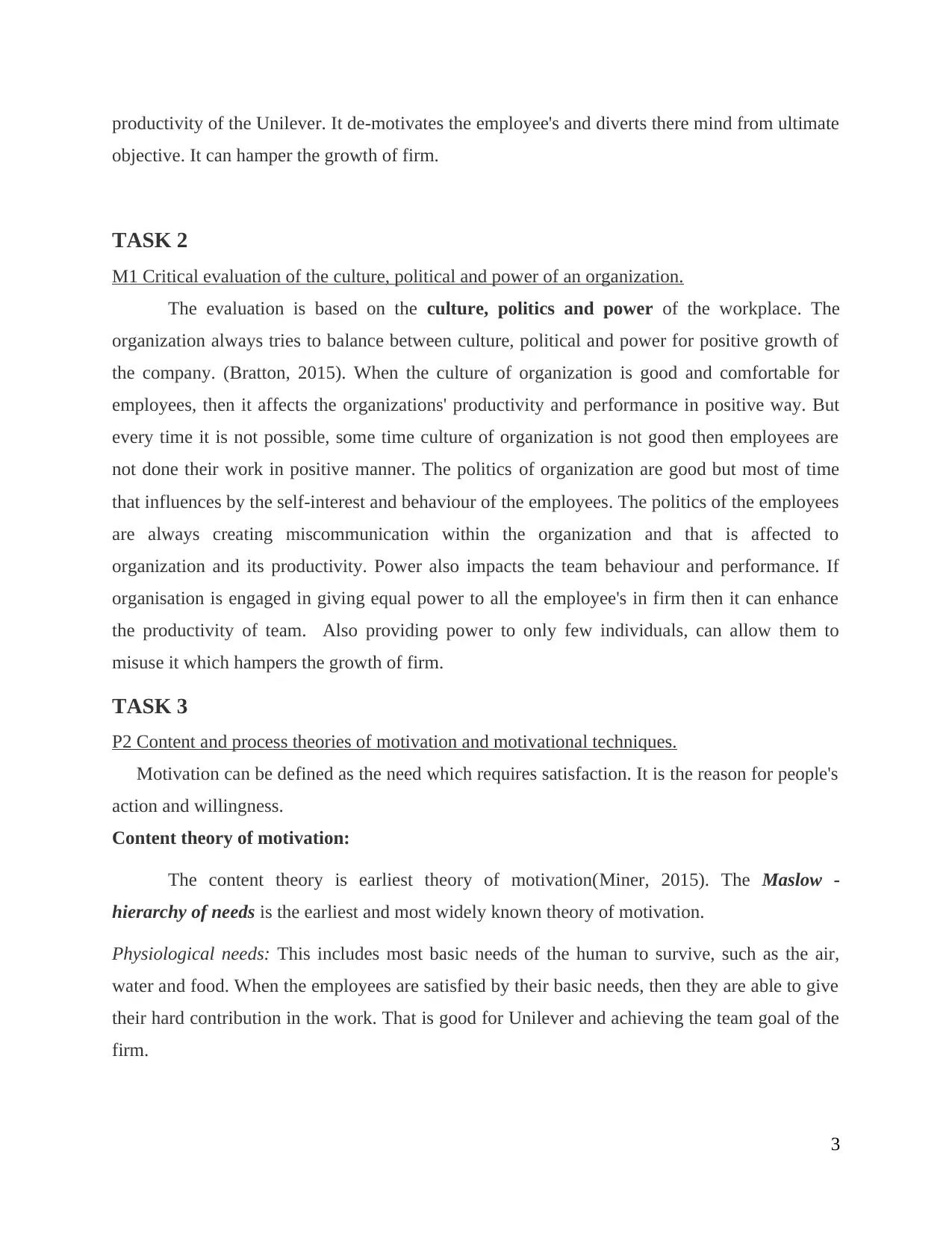
productivity of the Unilever. It de-motivates the employee's and diverts there mind from ultimate
objective. It can hamper the growth of firm.
TASK 2
M1 Critical evaluation of the culture, political and power of an organization.
The evaluation is based on the culture, politics and power of the workplace. The
organization always tries to balance between culture, political and power for positive growth of
the company. (Bratton, 2015). When the culture of organization is good and comfortable for
employees, then it affects the organizations' productivity and performance in positive way. But
every time it is not possible, some time culture of organization is not good then employees are
not done their work in positive manner. The politics of organization are good but most of time
that influences by the self-interest and behaviour of the employees. The politics of the employees
are always creating miscommunication within the organization and that is affected to
organization and its productivity. Power also impacts the team behaviour and performance. If
organisation is engaged in giving equal power to all the employee's in firm then it can enhance
the productivity of team. Also providing power to only few individuals, can allow them to
misuse it which hampers the growth of firm.
TASK 3
P2 Content and process theories of motivation and motivational techniques.
Motivation can be defined as the need which requires satisfaction. It is the reason for people's
action and willingness.
Content theory of motivation:
The content theory is earliest theory of motivation(Miner, 2015). The Maslow -
hierarchy of needs is the earliest and most widely known theory of motivation.
Physiological needs: This includes most basic needs of the human to survive, such as the air,
water and food. When the employees are satisfied by their basic needs, then they are able to give
their hard contribution in the work. That is good for Unilever and achieving the team goal of the
firm.
3
objective. It can hamper the growth of firm.
TASK 2
M1 Critical evaluation of the culture, political and power of an organization.
The evaluation is based on the culture, politics and power of the workplace. The
organization always tries to balance between culture, political and power for positive growth of
the company. (Bratton, 2015). When the culture of organization is good and comfortable for
employees, then it affects the organizations' productivity and performance in positive way. But
every time it is not possible, some time culture of organization is not good then employees are
not done their work in positive manner. The politics of organization are good but most of time
that influences by the self-interest and behaviour of the employees. The politics of the employees
are always creating miscommunication within the organization and that is affected to
organization and its productivity. Power also impacts the team behaviour and performance. If
organisation is engaged in giving equal power to all the employee's in firm then it can enhance
the productivity of team. Also providing power to only few individuals, can allow them to
misuse it which hampers the growth of firm.
TASK 3
P2 Content and process theories of motivation and motivational techniques.
Motivation can be defined as the need which requires satisfaction. It is the reason for people's
action and willingness.
Content theory of motivation:
The content theory is earliest theory of motivation(Miner, 2015). The Maslow -
hierarchy of needs is the earliest and most widely known theory of motivation.
Physiological needs: This includes most basic needs of the human to survive, such as the air,
water and food. When the employees are satisfied by their basic needs, then they are able to give
their hard contribution in the work. That is good for Unilever and achieving the team goal of the
firm.
3
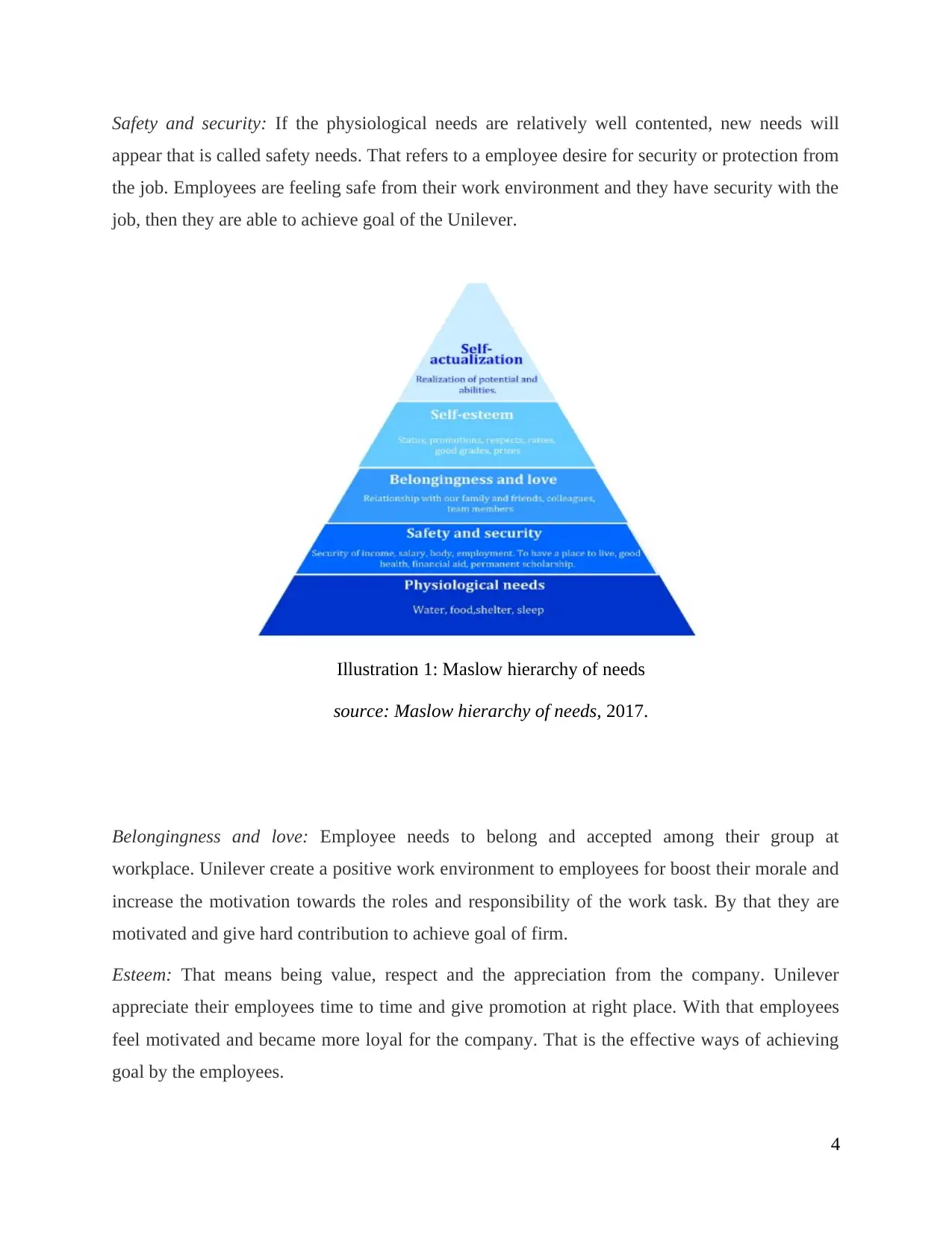
Safety and security: If the physiological needs are relatively well contented, new needs will
appear that is called safety needs. That refers to a employee desire for security or protection from
the job. Employees are feeling safe from their work environment and they have security with the
job, then they are able to achieve goal of the Unilever.
Belongingness and love: Employee needs to belong and accepted among their group at
workplace. Unilever create a positive work environment to employees for boost their morale and
increase the motivation towards the roles and responsibility of the work task. By that they are
motivated and give hard contribution to achieve goal of firm.
Esteem: That means being value, respect and the appreciation from the company. Unilever
appreciate their employees time to time and give promotion at right place. With that employees
feel motivated and became more loyal for the company. That is the effective ways of achieving
goal by the employees.
4
Illustration 1: Maslow hierarchy of needs
source: Maslow hierarchy of needs, 2017.
appear that is called safety needs. That refers to a employee desire for security or protection from
the job. Employees are feeling safe from their work environment and they have security with the
job, then they are able to achieve goal of the Unilever.
Belongingness and love: Employee needs to belong and accepted among their group at
workplace. Unilever create a positive work environment to employees for boost their morale and
increase the motivation towards the roles and responsibility of the work task. By that they are
motivated and give hard contribution to achieve goal of firm.
Esteem: That means being value, respect and the appreciation from the company. Unilever
appreciate their employees time to time and give promotion at right place. With that employees
feel motivated and became more loyal for the company. That is the effective ways of achieving
goal by the employees.
4
Illustration 1: Maslow hierarchy of needs
source: Maslow hierarchy of needs, 2017.
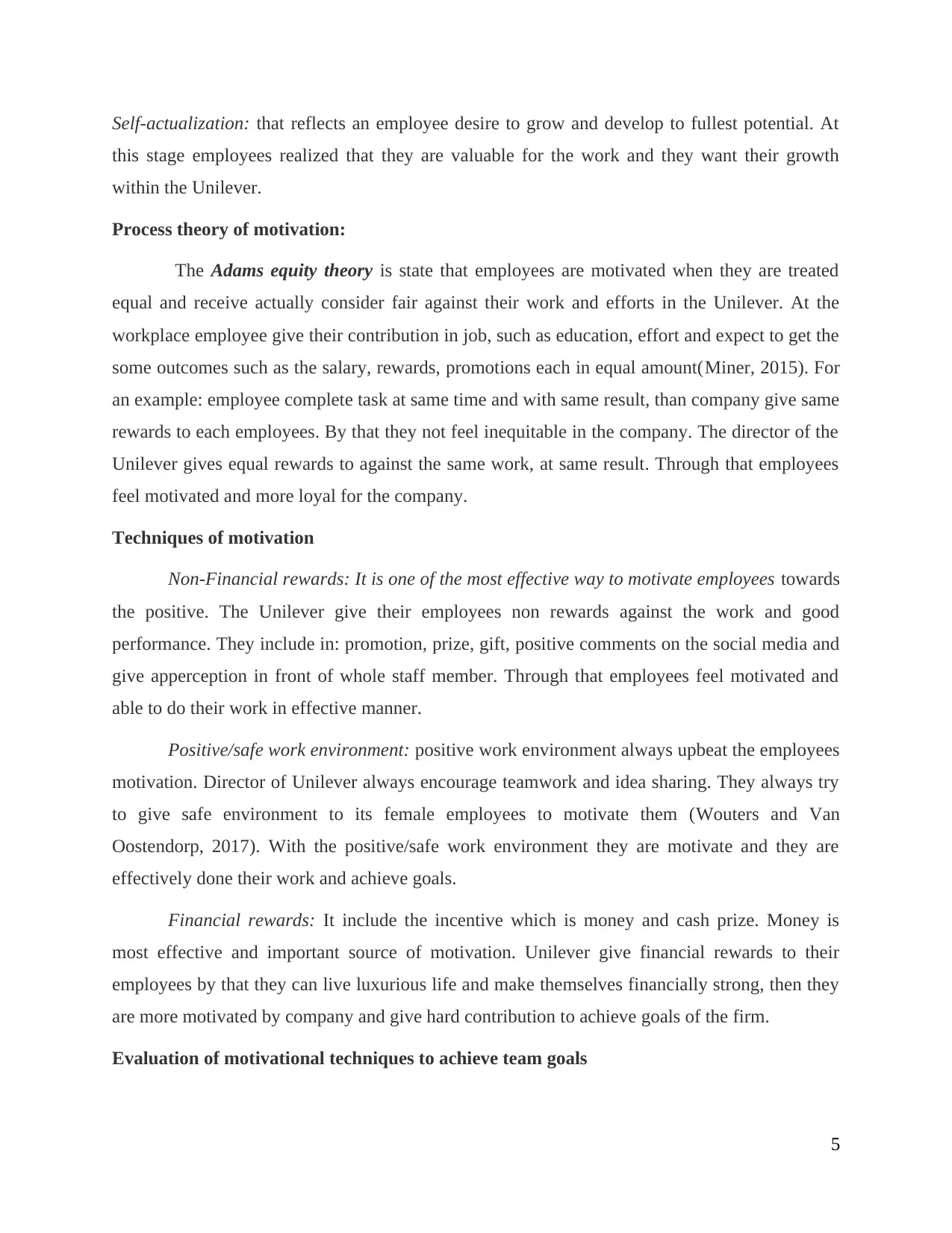
Self-actualization: that reflects an employee desire to grow and develop to fullest potential. At
this stage employees realized that they are valuable for the work and they want their growth
within the Unilever.
Process theory of motivation:
The Adams equity theory is state that employees are motivated when they are treated
equal and receive actually consider fair against their work and efforts in the Unilever. At the
workplace employee give their contribution in job, such as education, effort and expect to get the
some outcomes such as the salary, rewards, promotions each in equal amount(Miner, 2015). For
an example: employee complete task at same time and with same result, than company give same
rewards to each employees. By that they not feel inequitable in the company. The director of the
Unilever gives equal rewards to against the same work, at same result. Through that employees
feel motivated and more loyal for the company.
Techniques of motivation
Non-Financial rewards: It is one of the most effective way to motivate employees towards
the positive. The Unilever give their employees non rewards against the work and good
performance. They include in: promotion, prize, gift, positive comments on the social media and
give apperception in front of whole staff member. Through that employees feel motivated and
able to do their work in effective manner.
Positive/safe work environment: positive work environment always upbeat the employees
motivation. Director of Unilever always encourage teamwork and idea sharing. They always try
to give safe environment to its female employees to motivate them (Wouters and Van
Oostendorp, 2017). With the positive/safe work environment they are motivate and they are
effectively done their work and achieve goals.
Financial rewards: It include the incentive which is money and cash prize. Money is
most effective and important source of motivation. Unilever give financial rewards to their
employees by that they can live luxurious life and make themselves financially strong, then they
are more motivated by company and give hard contribution to achieve goals of the firm.
Evaluation of motivational techniques to achieve team goals
5
this stage employees realized that they are valuable for the work and they want their growth
within the Unilever.
Process theory of motivation:
The Adams equity theory is state that employees are motivated when they are treated
equal and receive actually consider fair against their work and efforts in the Unilever. At the
workplace employee give their contribution in job, such as education, effort and expect to get the
some outcomes such as the salary, rewards, promotions each in equal amount(Miner, 2015). For
an example: employee complete task at same time and with same result, than company give same
rewards to each employees. By that they not feel inequitable in the company. The director of the
Unilever gives equal rewards to against the same work, at same result. Through that employees
feel motivated and more loyal for the company.
Techniques of motivation
Non-Financial rewards: It is one of the most effective way to motivate employees towards
the positive. The Unilever give their employees non rewards against the work and good
performance. They include in: promotion, prize, gift, positive comments on the social media and
give apperception in front of whole staff member. Through that employees feel motivated and
able to do their work in effective manner.
Positive/safe work environment: positive work environment always upbeat the employees
motivation. Director of Unilever always encourage teamwork and idea sharing. They always try
to give safe environment to its female employees to motivate them (Wouters and Van
Oostendorp, 2017). With the positive/safe work environment they are motivate and they are
effectively done their work and achieve goals.
Financial rewards: It include the incentive which is money and cash prize. Money is
most effective and important source of motivation. Unilever give financial rewards to their
employees by that they can live luxurious life and make themselves financially strong, then they
are more motivated by company and give hard contribution to achieve goals of the firm.
Evaluation of motivational techniques to achieve team goals
5
Paraphrase This Document
Need a fresh take? Get an instant paraphrase of this document with our AI Paraphraser
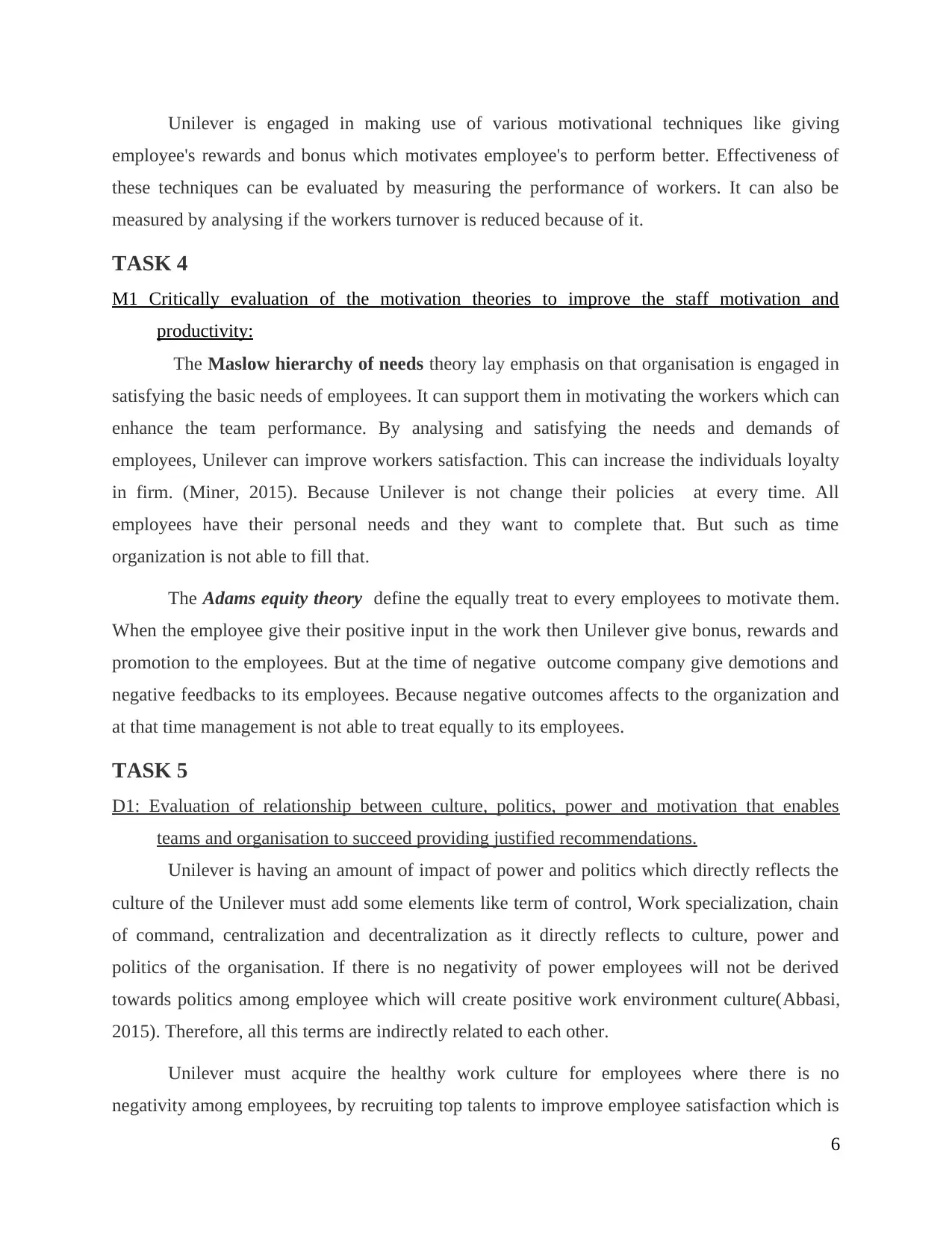
Unilever is engaged in making use of various motivational techniques like giving
employee's rewards and bonus which motivates employee's to perform better. Effectiveness of
these techniques can be evaluated by measuring the performance of workers. It can also be
measured by analysing if the workers turnover is reduced because of it.
TASK 4
M1 Critically evaluation of the motivation theories to improve the staff motivation and
productivity:
The Maslow hierarchy of needs theory lay emphasis on that organisation is engaged in
satisfying the basic needs of employees. It can support them in motivating the workers which can
enhance the team performance. By analysing and satisfying the needs and demands of
employees, Unilever can improve workers satisfaction. This can increase the individuals loyalty
in firm. (Miner, 2015). Because Unilever is not change their policies at every time. All
employees have their personal needs and they want to complete that. But such as time
organization is not able to fill that.
The Adams equity theory define the equally treat to every employees to motivate them.
When the employee give their positive input in the work then Unilever give bonus, rewards and
promotion to the employees. But at the time of negative outcome company give demotions and
negative feedbacks to its employees. Because negative outcomes affects to the organization and
at that time management is not able to treat equally to its employees.
TASK 5
D1: Evaluation of relationship between culture, politics, power and motivation that enables
teams and organisation to succeed providing justified recommendations.
Unilever is having an amount of impact of power and politics which directly reflects the
culture of the Unilever must add some elements like term of control, Work specialization, chain
of command, centralization and decentralization as it directly reflects to culture, power and
politics of the organisation. If there is no negativity of power employees will not be derived
towards politics among employee which will create positive work environment culture(Abbasi,
2015). Therefore, all this terms are indirectly related to each other.
Unilever must acquire the healthy work culture for employees where there is no
negativity among employees, by recruiting top talents to improve employee satisfaction which is
6
employee's rewards and bonus which motivates employee's to perform better. Effectiveness of
these techniques can be evaluated by measuring the performance of workers. It can also be
measured by analysing if the workers turnover is reduced because of it.
TASK 4
M1 Critically evaluation of the motivation theories to improve the staff motivation and
productivity:
The Maslow hierarchy of needs theory lay emphasis on that organisation is engaged in
satisfying the basic needs of employees. It can support them in motivating the workers which can
enhance the team performance. By analysing and satisfying the needs and demands of
employees, Unilever can improve workers satisfaction. This can increase the individuals loyalty
in firm. (Miner, 2015). Because Unilever is not change their policies at every time. All
employees have their personal needs and they want to complete that. But such as time
organization is not able to fill that.
The Adams equity theory define the equally treat to every employees to motivate them.
When the employee give their positive input in the work then Unilever give bonus, rewards and
promotion to the employees. But at the time of negative outcome company give demotions and
negative feedbacks to its employees. Because negative outcomes affects to the organization and
at that time management is not able to treat equally to its employees.
TASK 5
D1: Evaluation of relationship between culture, politics, power and motivation that enables
teams and organisation to succeed providing justified recommendations.
Unilever is having an amount of impact of power and politics which directly reflects the
culture of the Unilever must add some elements like term of control, Work specialization, chain
of command, centralization and decentralization as it directly reflects to culture, power and
politics of the organisation. If there is no negativity of power employees will not be derived
towards politics among employee which will create positive work environment culture(Abbasi,
2015). Therefore, all this terms are indirectly related to each other.
Unilever must acquire the healthy work culture for employees where there is no
negativity among employees, by recruiting top talents to improve employee satisfaction which is
6
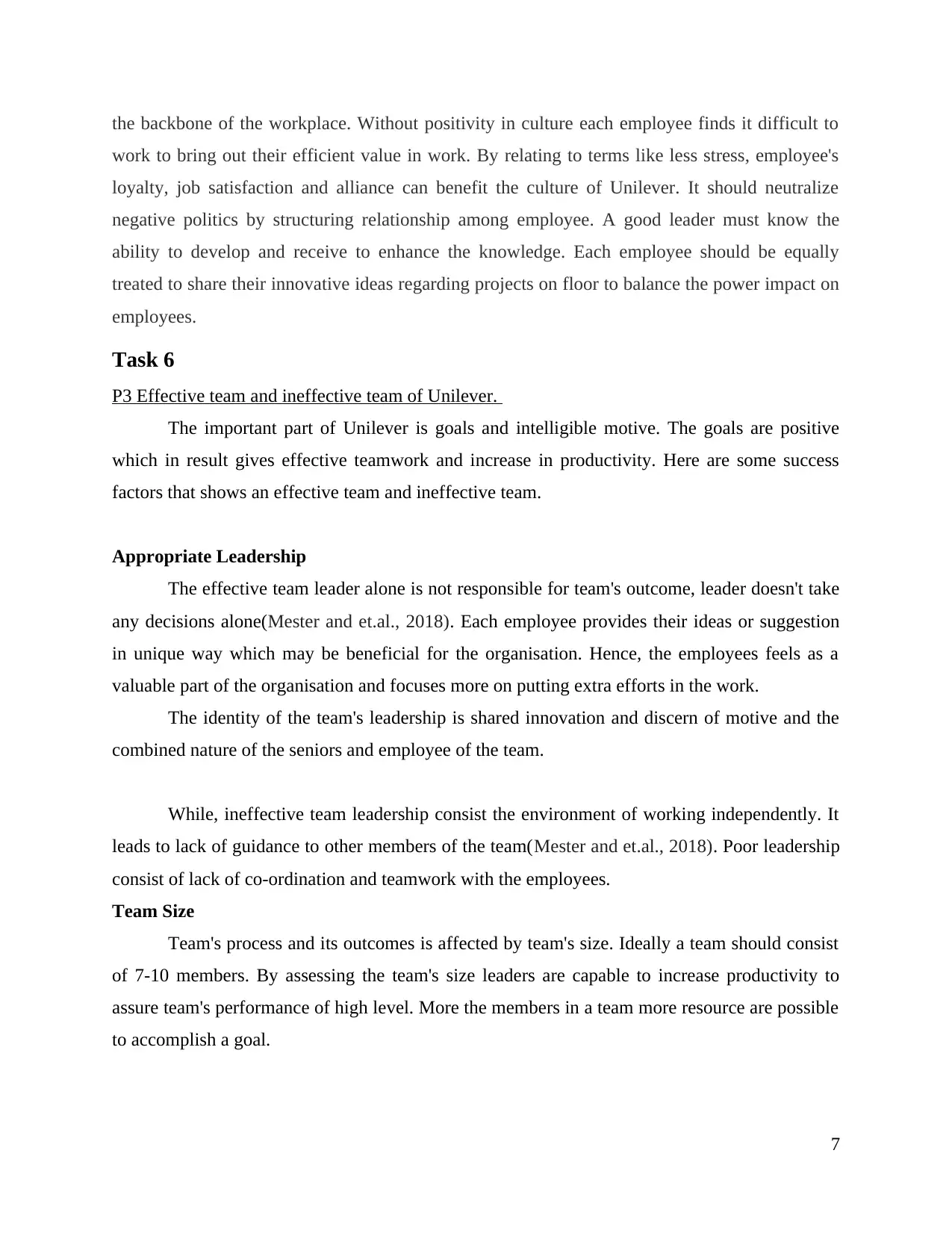
the backbone of the workplace. Without positivity in culture each employee finds it difficult to
work to bring out their efficient value in work. By relating to terms like less stress, employee's
loyalty, job satisfaction and alliance can benefit the culture of Unilever. It should neutralize
negative politics by structuring relationship among employee. A good leader must know the
ability to develop and receive to enhance the knowledge. Each employee should be equally
treated to share their innovative ideas regarding projects on floor to balance the power impact on
employees.
Task 6
P3 Effective team and ineffective team of Unilever.
The important part of Unilever is goals and intelligible motive. The goals are positive
which in result gives effective teamwork and increase in productivity. Here are some success
factors that shows an effective team and ineffective team.
Appropriate Leadership
The effective team leader alone is not responsible for team's outcome, leader doesn't take
any decisions alone(Mester and et.al., 2018). Each employee provides their ideas or suggestion
in unique way which may be beneficial for the organisation. Hence, the employees feels as a
valuable part of the organisation and focuses more on putting extra efforts in the work.
The identity of the team's leadership is shared innovation and discern of motive and the
combined nature of the seniors and employee of the team.
While, ineffective team leadership consist the environment of working independently. It
leads to lack of guidance to other members of the team(Mester and et.al., 2018). Poor leadership
consist of lack of co-ordination and teamwork with the employees.
Team Size
Team's process and its outcomes is affected by team's size. Ideally a team should consist
of 7-10 members. By assessing the team's size leaders are capable to increase productivity to
assure team's performance of high level. More the members in a team more resource are possible
to accomplish a goal.
7
work to bring out their efficient value in work. By relating to terms like less stress, employee's
loyalty, job satisfaction and alliance can benefit the culture of Unilever. It should neutralize
negative politics by structuring relationship among employee. A good leader must know the
ability to develop and receive to enhance the knowledge. Each employee should be equally
treated to share their innovative ideas regarding projects on floor to balance the power impact on
employees.
Task 6
P3 Effective team and ineffective team of Unilever.
The important part of Unilever is goals and intelligible motive. The goals are positive
which in result gives effective teamwork and increase in productivity. Here are some success
factors that shows an effective team and ineffective team.
Appropriate Leadership
The effective team leader alone is not responsible for team's outcome, leader doesn't take
any decisions alone(Mester and et.al., 2018). Each employee provides their ideas or suggestion
in unique way which may be beneficial for the organisation. Hence, the employees feels as a
valuable part of the organisation and focuses more on putting extra efforts in the work.
The identity of the team's leadership is shared innovation and discern of motive and the
combined nature of the seniors and employee of the team.
While, ineffective team leadership consist the environment of working independently. It
leads to lack of guidance to other members of the team(Mester and et.al., 2018). Poor leadership
consist of lack of co-ordination and teamwork with the employees.
Team Size
Team's process and its outcomes is affected by team's size. Ideally a team should consist
of 7-10 members. By assessing the team's size leaders are capable to increase productivity to
assure team's performance of high level. More the members in a team more resource are possible
to accomplish a goal.
7
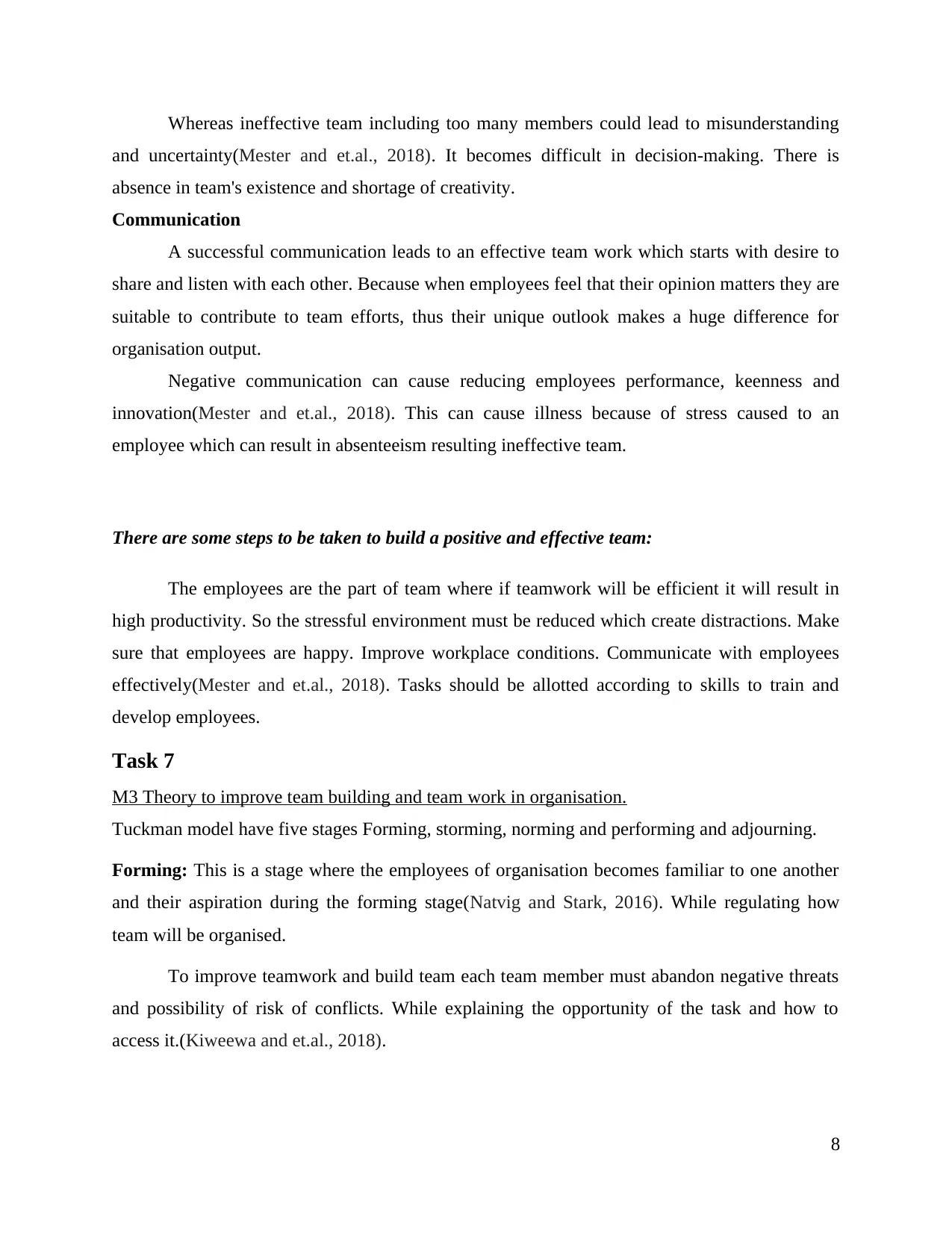
Whereas ineffective team including too many members could lead to misunderstanding
and uncertainty(Mester and et.al., 2018). It becomes difficult in decision-making. There is
absence in team's existence and shortage of creativity.
Communication
A successful communication leads to an effective team work which starts with desire to
share and listen with each other. Because when employees feel that their opinion matters they are
suitable to contribute to team efforts, thus their unique outlook makes a huge difference for
organisation output.
Negative communication can cause reducing employees performance, keenness and
innovation(Mester and et.al., 2018). This can cause illness because of stress caused to an
employee which can result in absenteeism resulting ineffective team.
There are some steps to be taken to build a positive and effective team:
The employees are the part of team where if teamwork will be efficient it will result in
high productivity. So the stressful environment must be reduced which create distractions. Make
sure that employees are happy. Improve workplace conditions. Communicate with employees
effectively(Mester and et.al., 2018). Tasks should be allotted according to skills to train and
develop employees.
Task 7
M3 Theory to improve team building and team work in organisation.
Tuckman model have five stages Forming, storming, norming and performing and adjourning.
Forming: This is a stage where the employees of organisation becomes familiar to one another
and their aspiration during the forming stage(Natvig and Stark, 2016). While regulating how
team will be organised.
To improve teamwork and build team each team member must abandon negative threats
and possibility of risk of conflicts. While explaining the opportunity of the task and how to
access it.(Kiweewa and et.al., 2018).
8
and uncertainty(Mester and et.al., 2018). It becomes difficult in decision-making. There is
absence in team's existence and shortage of creativity.
Communication
A successful communication leads to an effective team work which starts with desire to
share and listen with each other. Because when employees feel that their opinion matters they are
suitable to contribute to team efforts, thus their unique outlook makes a huge difference for
organisation output.
Negative communication can cause reducing employees performance, keenness and
innovation(Mester and et.al., 2018). This can cause illness because of stress caused to an
employee which can result in absenteeism resulting ineffective team.
There are some steps to be taken to build a positive and effective team:
The employees are the part of team where if teamwork will be efficient it will result in
high productivity. So the stressful environment must be reduced which create distractions. Make
sure that employees are happy. Improve workplace conditions. Communicate with employees
effectively(Mester and et.al., 2018). Tasks should be allotted according to skills to train and
develop employees.
Task 7
M3 Theory to improve team building and team work in organisation.
Tuckman model have five stages Forming, storming, norming and performing and adjourning.
Forming: This is a stage where the employees of organisation becomes familiar to one another
and their aspiration during the forming stage(Natvig and Stark, 2016). While regulating how
team will be organised.
To improve teamwork and build team each team member must abandon negative threats
and possibility of risk of conflicts. While explaining the opportunity of the task and how to
access it.(Kiweewa and et.al., 2018).
8
Secure Best Marks with AI Grader
Need help grading? Try our AI Grader for instant feedback on your assignments.
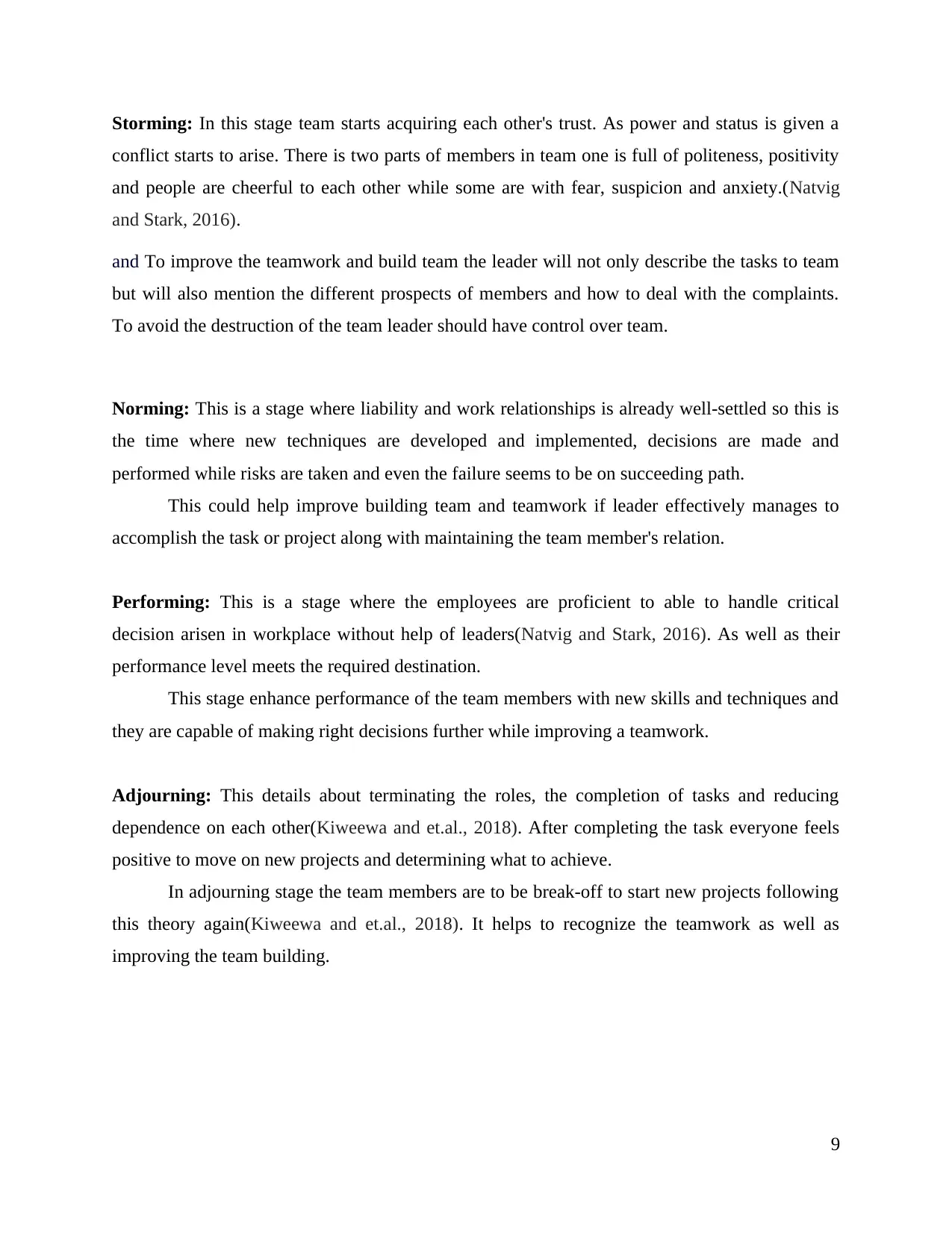
Storming: In this stage team starts acquiring each other's trust. As power and status is given a
conflict starts to arise. There is two parts of members in team one is full of politeness, positivity
and people are cheerful to each other while some are with fear, suspicion and anxiety.(Natvig
and Stark, 2016).
and To improve the teamwork and build team the leader will not only describe the tasks to team
but will also mention the different prospects of members and how to deal with the complaints.
To avoid the destruction of the team leader should have control over team.
Norming: This is a stage where liability and work relationships is already well-settled so this is
the time where new techniques are developed and implemented, decisions are made and
performed while risks are taken and even the failure seems to be on succeeding path.
This could help improve building team and teamwork if leader effectively manages to
accomplish the task or project along with maintaining the team member's relation.
Performing: This is a stage where the employees are proficient to able to handle critical
decision arisen in workplace without help of leaders(Natvig and Stark, 2016). As well as their
performance level meets the required destination.
This stage enhance performance of the team members with new skills and techniques and
they are capable of making right decisions further while improving a teamwork.
Adjourning: This details about terminating the roles, the completion of tasks and reducing
dependence on each other(Kiweewa and et.al., 2018). After completing the task everyone feels
positive to move on new projects and determining what to achieve.
In adjourning stage the team members are to be break-off to start new projects following
this theory again(Kiweewa and et.al., 2018). It helps to recognize the teamwork as well as
improving the team building.
9
conflict starts to arise. There is two parts of members in team one is full of politeness, positivity
and people are cheerful to each other while some are with fear, suspicion and anxiety.(Natvig
and Stark, 2016).
and To improve the teamwork and build team the leader will not only describe the tasks to team
but will also mention the different prospects of members and how to deal with the complaints.
To avoid the destruction of the team leader should have control over team.
Norming: This is a stage where liability and work relationships is already well-settled so this is
the time where new techniques are developed and implemented, decisions are made and
performed while risks are taken and even the failure seems to be on succeeding path.
This could help improve building team and teamwork if leader effectively manages to
accomplish the task or project along with maintaining the team member's relation.
Performing: This is a stage where the employees are proficient to able to handle critical
decision arisen in workplace without help of leaders(Natvig and Stark, 2016). As well as their
performance level meets the required destination.
This stage enhance performance of the team members with new skills and techniques and
they are capable of making right decisions further while improving a teamwork.
Adjourning: This details about terminating the roles, the completion of tasks and reducing
dependence on each other(Kiweewa and et.al., 2018). After completing the task everyone feels
positive to move on new projects and determining what to achieve.
In adjourning stage the team members are to be break-off to start new projects following
this theory again(Kiweewa and et.al., 2018). It helps to recognize the teamwork as well as
improving the team building.
9
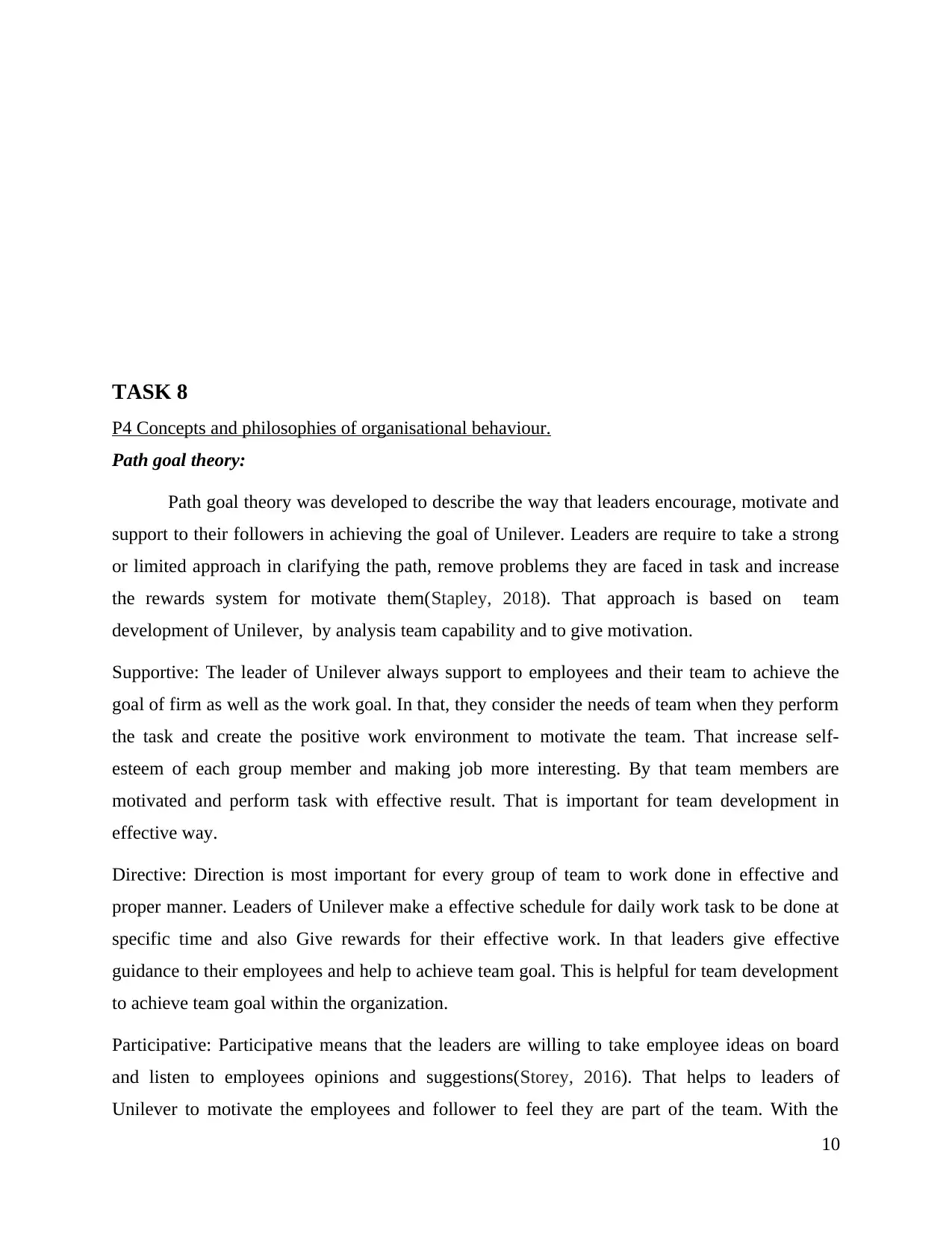
TASK 8
P4 Concepts and philosophies of organisational behaviour.
Path goal theory:
Path goal theory was developed to describe the way that leaders encourage, motivate and
support to their followers in achieving the goal of Unilever. Leaders are require to take a strong
or limited approach in clarifying the path, remove problems they are faced in task and increase
the rewards system for motivate them(Stapley, 2018). That approach is based on team
development of Unilever, by analysis team capability and to give motivation.
Supportive: The leader of Unilever always support to employees and their team to achieve the
goal of firm as well as the work goal. In that, they consider the needs of team when they perform
the task and create the positive work environment to motivate the team. That increase self-
esteem of each group member and making job more interesting. By that team members are
motivated and perform task with effective result. That is important for team development in
effective way.
Directive: Direction is most important for every group of team to work done in effective and
proper manner. Leaders of Unilever make a effective schedule for daily work task to be done at
specific time and also Give rewards for their effective work. In that leaders give effective
guidance to their employees and help to achieve team goal. This is helpful for team development
to achieve team goal within the organization.
Participative: Participative means that the leaders are willing to take employee ideas on board
and listen to employees opinions and suggestions(Storey, 2016). That helps to leaders of
Unilever to motivate the employees and follower to feel they are part of the team. With the
10
P4 Concepts and philosophies of organisational behaviour.
Path goal theory:
Path goal theory was developed to describe the way that leaders encourage, motivate and
support to their followers in achieving the goal of Unilever. Leaders are require to take a strong
or limited approach in clarifying the path, remove problems they are faced in task and increase
the rewards system for motivate them(Stapley, 2018). That approach is based on team
development of Unilever, by analysis team capability and to give motivation.
Supportive: The leader of Unilever always support to employees and their team to achieve the
goal of firm as well as the work goal. In that, they consider the needs of team when they perform
the task and create the positive work environment to motivate the team. That increase self-
esteem of each group member and making job more interesting. By that team members are
motivated and perform task with effective result. That is important for team development in
effective way.
Directive: Direction is most important for every group of team to work done in effective and
proper manner. Leaders of Unilever make a effective schedule for daily work task to be done at
specific time and also Give rewards for their effective work. In that leaders give effective
guidance to their employees and help to achieve team goal. This is helpful for team development
to achieve team goal within the organization.
Participative: Participative means that the leaders are willing to take employee ideas on board
and listen to employees opinions and suggestions(Storey, 2016). That helps to leaders of
Unilever to motivate the employees and follower to feel they are part of the team. With the
10
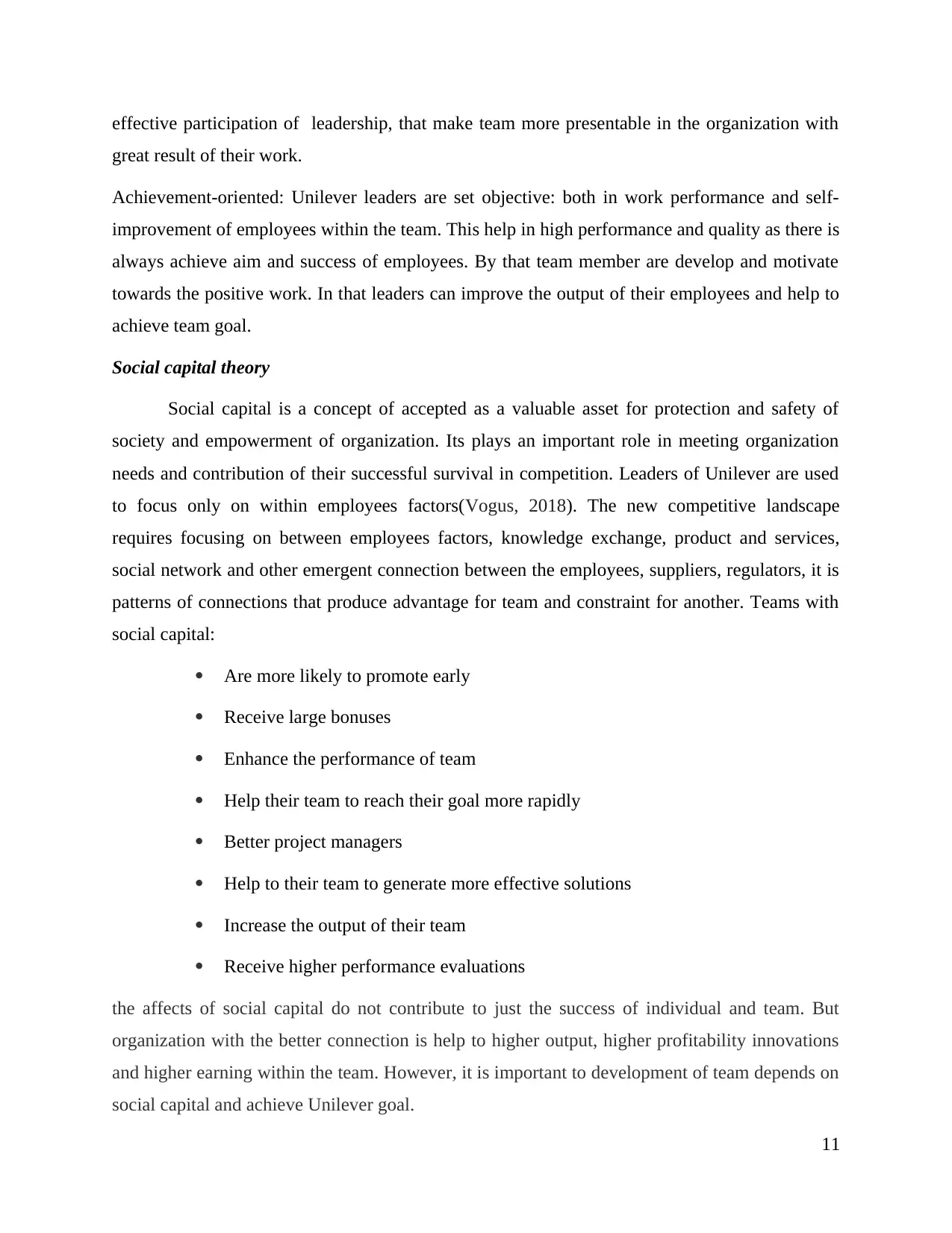
effective participation of leadership, that make team more presentable in the organization with
great result of their work.
Achievement-oriented: Unilever leaders are set objective: both in work performance and self-
improvement of employees within the team. This help in high performance and quality as there is
always achieve aim and success of employees. By that team member are develop and motivate
towards the positive work. In that leaders can improve the output of their employees and help to
achieve team goal.
Social capital theory
Social capital is a concept of accepted as a valuable asset for protection and safety of
society and empowerment of organization. Its plays an important role in meeting organization
needs and contribution of their successful survival in competition. Leaders of Unilever are used
to focus only on within employees factors(Vogus, 2018). The new competitive landscape
requires focusing on between employees factors, knowledge exchange, product and services,
social network and other emergent connection between the employees, suppliers, regulators, it is
patterns of connections that produce advantage for team and constraint for another. Teams with
social capital:
Are more likely to promote early
Receive large bonuses
Enhance the performance of team
Help their team to reach their goal more rapidly
Better project managers
Help to their team to generate more effective solutions
Increase the output of their team
Receive higher performance evaluations
the affects of social capital do not contribute to just the success of individual and team. But
organization with the better connection is help to higher output, higher profitability innovations
and higher earning within the team. However, it is important to development of team depends on
social capital and achieve Unilever goal.
11
great result of their work.
Achievement-oriented: Unilever leaders are set objective: both in work performance and self-
improvement of employees within the team. This help in high performance and quality as there is
always achieve aim and success of employees. By that team member are develop and motivate
towards the positive work. In that leaders can improve the output of their employees and help to
achieve team goal.
Social capital theory
Social capital is a concept of accepted as a valuable asset for protection and safety of
society and empowerment of organization. Its plays an important role in meeting organization
needs and contribution of their successful survival in competition. Leaders of Unilever are used
to focus only on within employees factors(Vogus, 2018). The new competitive landscape
requires focusing on between employees factors, knowledge exchange, product and services,
social network and other emergent connection between the employees, suppliers, regulators, it is
patterns of connections that produce advantage for team and constraint for another. Teams with
social capital:
Are more likely to promote early
Receive large bonuses
Enhance the performance of team
Help their team to reach their goal more rapidly
Better project managers
Help to their team to generate more effective solutions
Increase the output of their team
Receive higher performance evaluations
the affects of social capital do not contribute to just the success of individual and team. But
organization with the better connection is help to higher output, higher profitability innovations
and higher earning within the team. However, it is important to development of team depends on
social capital and achieve Unilever goal.
11
Paraphrase This Document
Need a fresh take? Get an instant paraphrase of this document with our AI Paraphraser
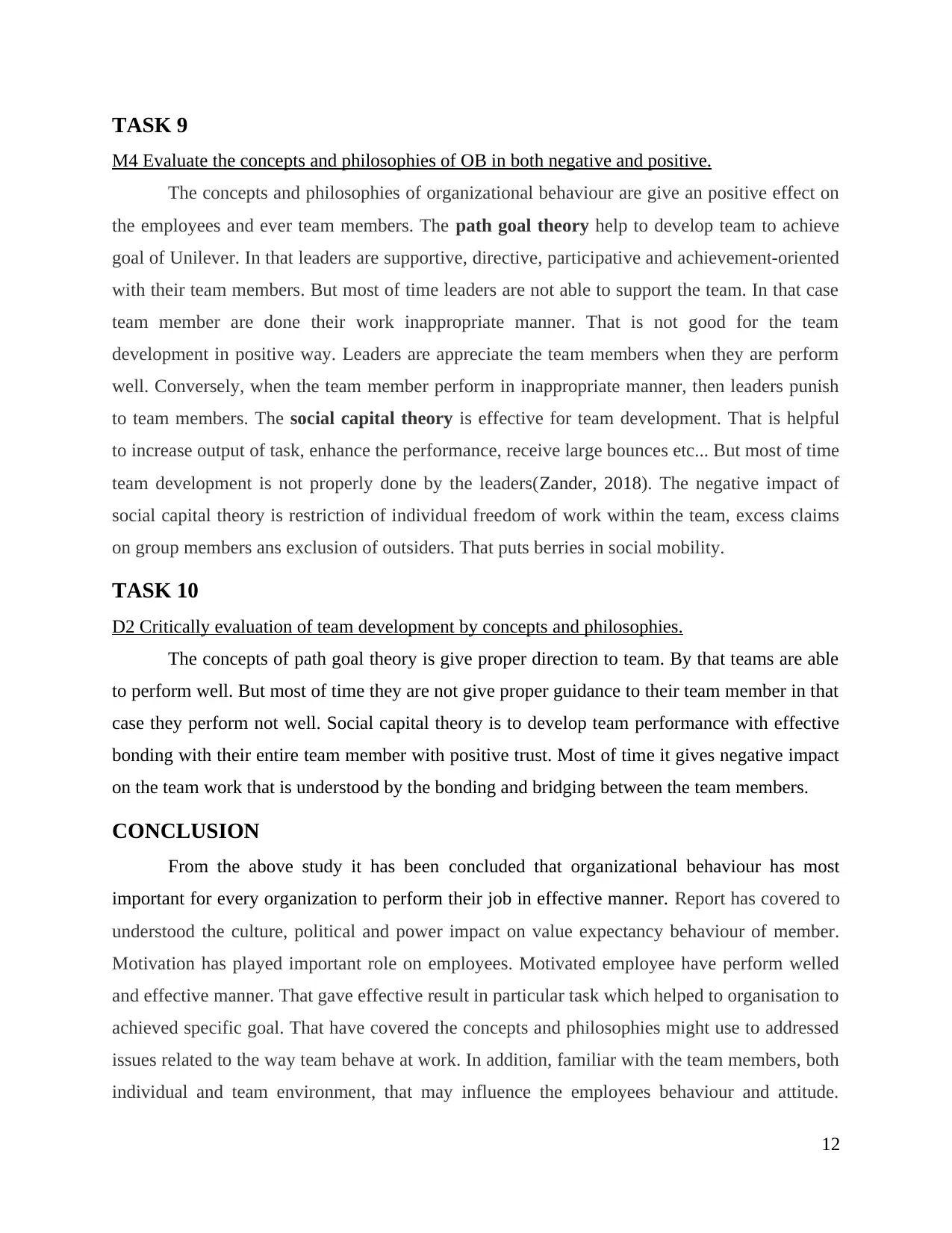
TASK 9
M4 Evaluate the concepts and philosophies of OB in both negative and positive.
The concepts and philosophies of organizational behaviour are give an positive effect on
the employees and ever team members. The path goal theory help to develop team to achieve
goal of Unilever. In that leaders are supportive, directive, participative and achievement-oriented
with their team members. But most of time leaders are not able to support the team. In that case
team member are done their work inappropriate manner. That is not good for the team
development in positive way. Leaders are appreciate the team members when they are perform
well. Conversely, when the team member perform in inappropriate manner, then leaders punish
to team members. The social capital theory is effective for team development. That is helpful
to increase output of task, enhance the performance, receive large bounces etc... But most of time
team development is not properly done by the leaders(Zander, 2018). The negative impact of
social capital theory is restriction of individual freedom of work within the team, excess claims
on group members ans exclusion of outsiders. That puts berries in social mobility.
TASK 10
D2 Critically evaluation of team development by concepts and philosophies.
The concepts of path goal theory is give proper direction to team. By that teams are able
to perform well. But most of time they are not give proper guidance to their team member in that
case they perform not well. Social capital theory is to develop team performance with effective
bonding with their entire team member with positive trust. Most of time it gives negative impact
on the team work that is understood by the bonding and bridging between the team members.
CONCLUSION
From the above study it has been concluded that organizational behaviour has most
important for every organization to perform their job in effective manner. Report has covered to
understood the culture, political and power impact on value expectancy behaviour of member.
Motivation has played important role on employees. Motivated employee have perform welled
and effective manner. That gave effective result in particular task which helped to organisation to
achieved specific goal. That have covered the concepts and philosophies might use to addressed
issues related to the way team behave at work. In addition, familiar with the team members, both
individual and team environment, that may influence the employees behaviour and attitude.
12
M4 Evaluate the concepts and philosophies of OB in both negative and positive.
The concepts and philosophies of organizational behaviour are give an positive effect on
the employees and ever team members. The path goal theory help to develop team to achieve
goal of Unilever. In that leaders are supportive, directive, participative and achievement-oriented
with their team members. But most of time leaders are not able to support the team. In that case
team member are done their work inappropriate manner. That is not good for the team
development in positive way. Leaders are appreciate the team members when they are perform
well. Conversely, when the team member perform in inappropriate manner, then leaders punish
to team members. The social capital theory is effective for team development. That is helpful
to increase output of task, enhance the performance, receive large bounces etc... But most of time
team development is not properly done by the leaders(Zander, 2018). The negative impact of
social capital theory is restriction of individual freedom of work within the team, excess claims
on group members ans exclusion of outsiders. That puts berries in social mobility.
TASK 10
D2 Critically evaluation of team development by concepts and philosophies.
The concepts of path goal theory is give proper direction to team. By that teams are able
to perform well. But most of time they are not give proper guidance to their team member in that
case they perform not well. Social capital theory is to develop team performance with effective
bonding with their entire team member with positive trust. Most of time it gives negative impact
on the team work that is understood by the bonding and bridging between the team members.
CONCLUSION
From the above study it has been concluded that organizational behaviour has most
important for every organization to perform their job in effective manner. Report has covered to
understood the culture, political and power impact on value expectancy behaviour of member.
Motivation has played important role on employees. Motivated employee have perform welled
and effective manner. That gave effective result in particular task which helped to organisation to
achieved specific goal. That have covered the concepts and philosophies might use to addressed
issues related to the way team behave at work. In addition, familiar with the team members, both
individual and team environment, that may influence the employees behaviour and attitude.
12
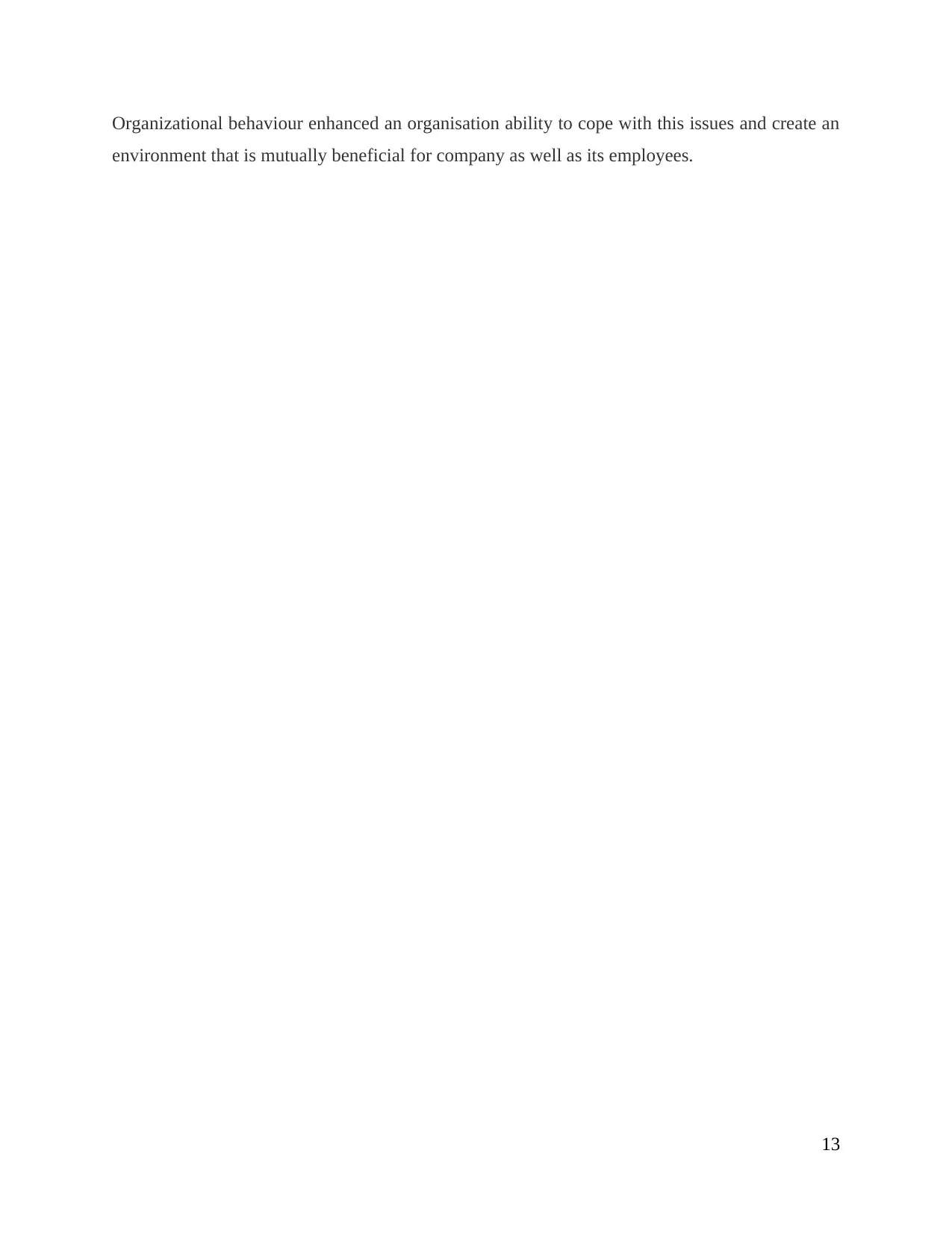
Organizational behaviour enhanced an organisation ability to cope with this issues and create an
environment that is mutually beneficial for company as well as its employees.
13
environment that is mutually beneficial for company as well as its employees.
13
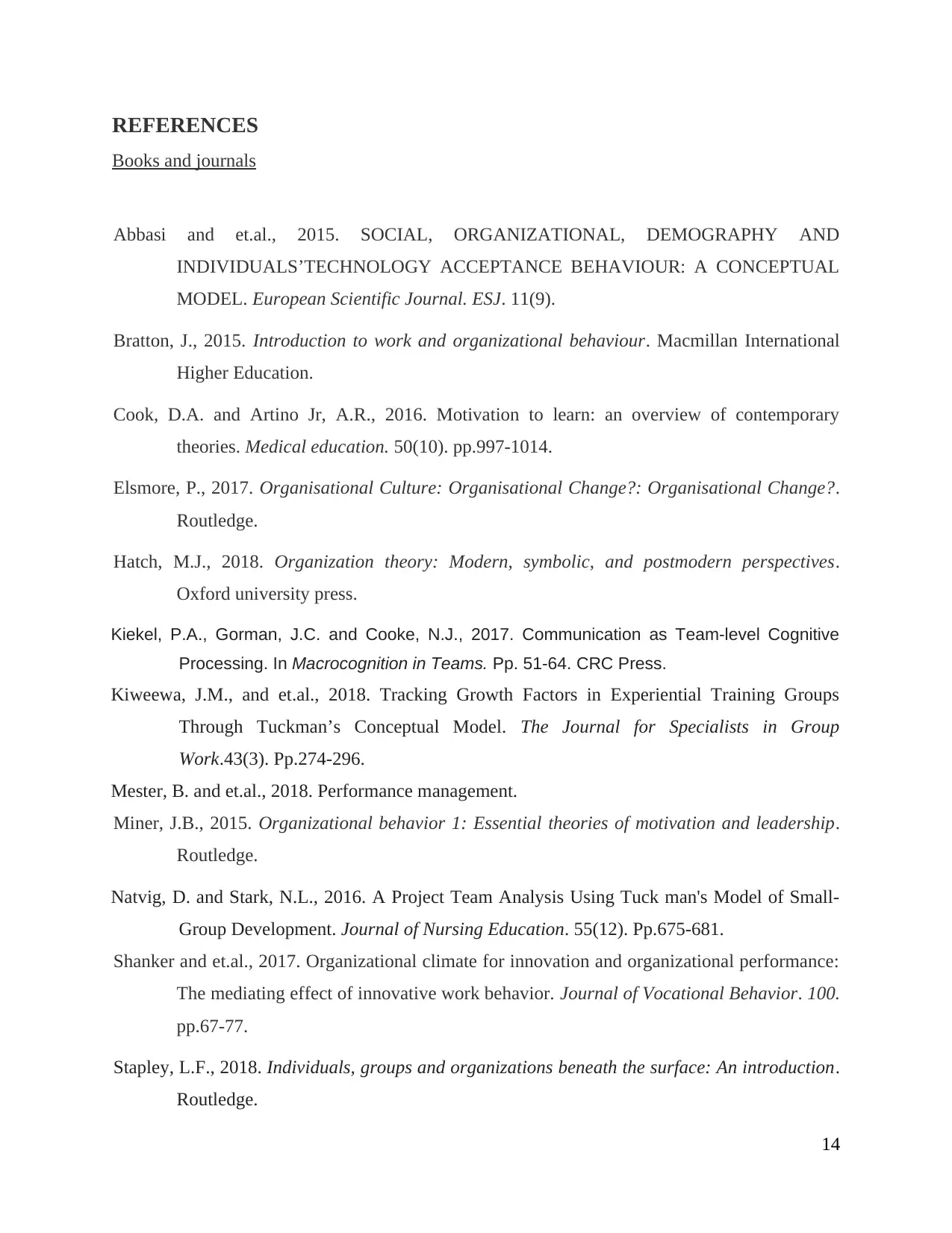
REFERENCES
Books and journals
Abbasi and et.al., 2015. SOCIAL, ORGANIZATIONAL, DEMOGRAPHY AND
INDIVIDUALS’TECHNOLOGY ACCEPTANCE BEHAVIOUR: A CONCEPTUAL
MODEL. European Scientific Journal. ESJ. 11(9).
Bratton, J., 2015. Introduction to work and organizational behaviour. Macmillan International
Higher Education.
Cook, D.A. and Artino Jr, A.R., 2016. Motivation to learn: an overview of contemporary
theories. Medical education. 50(10). pp.997-1014.
Elsmore, P., 2017. Organisational Culture: Organisational Change?: Organisational Change?.
Routledge.
Hatch, M.J., 2018. Organization theory: Modern, symbolic, and postmodern perspectives.
Oxford university press.
Kiekel, P.A., Gorman, J.C. and Cooke, N.J., 2017. Communication as Team-level Cognitive
Processing. In Macrocognition in Teams. Pp. 51-64. CRC Press.
Kiweewa, J.M., and et.al., 2018. Tracking Growth Factors in Experiential Training Groups
Through Tuckman’s Conceptual Model. The Journal for Specialists in Group
Work.43(3). Pp.274-296.
Mester, B. and et.al., 2018. Performance management.
Miner, J.B., 2015. Organizational behavior 1: Essential theories of motivation and leadership.
Routledge.
Natvig, D. and Stark, N.L., 2016. A Project Team Analysis Using Tuck man's Model of Small-
Group Development. Journal of Nursing Education. 55(12). Pp.675-681.
Shanker and et.al., 2017. Organizational climate for innovation and organizational performance:
The mediating effect of innovative work behavior. Journal of Vocational Behavior. 100.
pp.67-77.
Stapley, L.F., 2018. Individuals, groups and organizations beneath the surface: An introduction.
Routledge.
14
Books and journals
Abbasi and et.al., 2015. SOCIAL, ORGANIZATIONAL, DEMOGRAPHY AND
INDIVIDUALS’TECHNOLOGY ACCEPTANCE BEHAVIOUR: A CONCEPTUAL
MODEL. European Scientific Journal. ESJ. 11(9).
Bratton, J., 2015. Introduction to work and organizational behaviour. Macmillan International
Higher Education.
Cook, D.A. and Artino Jr, A.R., 2016. Motivation to learn: an overview of contemporary
theories. Medical education. 50(10). pp.997-1014.
Elsmore, P., 2017. Organisational Culture: Organisational Change?: Organisational Change?.
Routledge.
Hatch, M.J., 2018. Organization theory: Modern, symbolic, and postmodern perspectives.
Oxford university press.
Kiekel, P.A., Gorman, J.C. and Cooke, N.J., 2017. Communication as Team-level Cognitive
Processing. In Macrocognition in Teams. Pp. 51-64. CRC Press.
Kiweewa, J.M., and et.al., 2018. Tracking Growth Factors in Experiential Training Groups
Through Tuckman’s Conceptual Model. The Journal for Specialists in Group
Work.43(3). Pp.274-296.
Mester, B. and et.al., 2018. Performance management.
Miner, J.B., 2015. Organizational behavior 1: Essential theories of motivation and leadership.
Routledge.
Natvig, D. and Stark, N.L., 2016. A Project Team Analysis Using Tuck man's Model of Small-
Group Development. Journal of Nursing Education. 55(12). Pp.675-681.
Shanker and et.al., 2017. Organizational climate for innovation and organizational performance:
The mediating effect of innovative work behavior. Journal of Vocational Behavior. 100.
pp.67-77.
Stapley, L.F., 2018. Individuals, groups and organizations beneath the surface: An introduction.
Routledge.
14
Secure Best Marks with AI Grader
Need help grading? Try our AI Grader for instant feedback on your assignments.
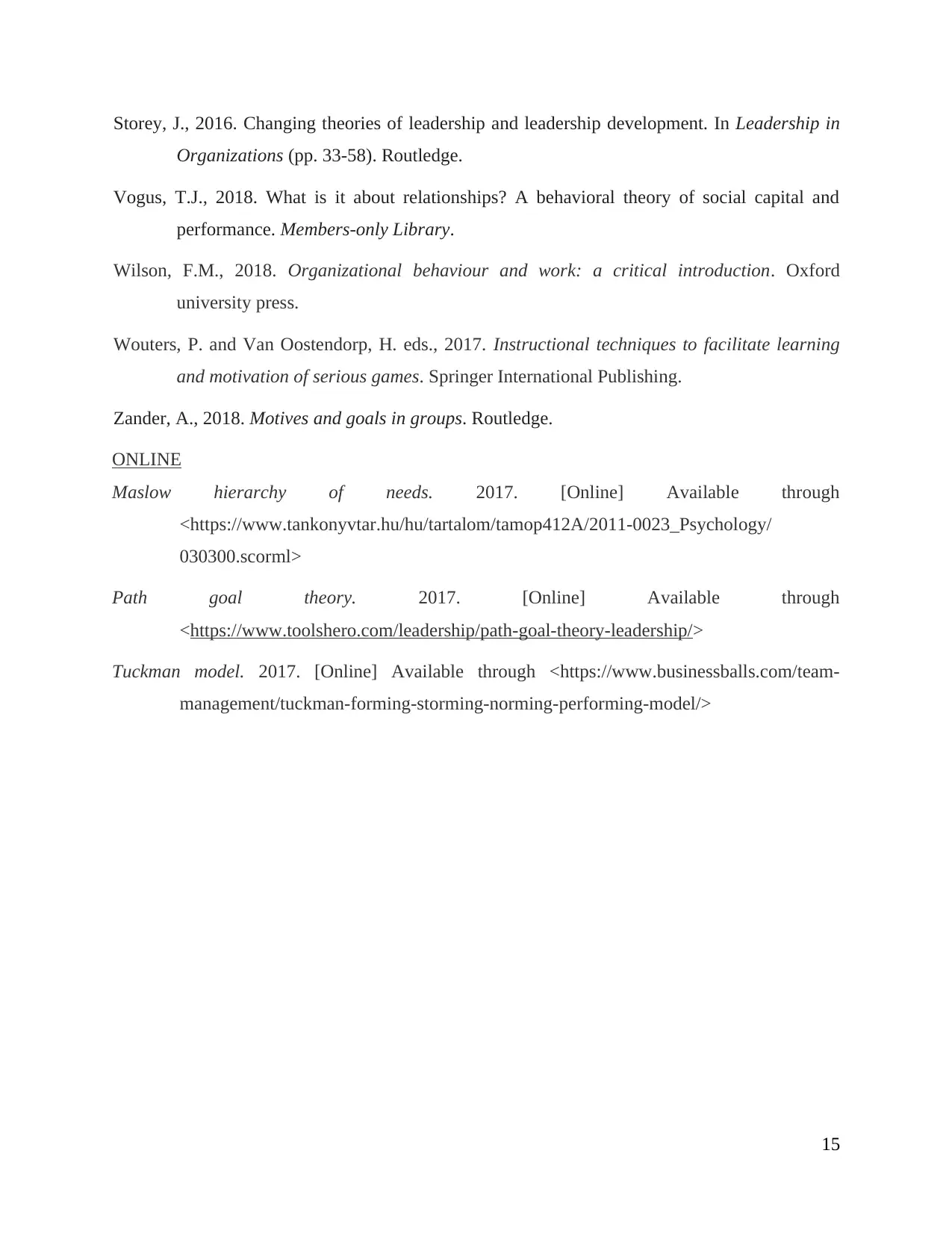
Storey, J., 2016. Changing theories of leadership and leadership development. In Leadership in
Organizations (pp. 33-58). Routledge.
Vogus, T.J., 2018. What is it about relationships? A behavioral theory of social capital and
performance. Members-only Library.
Wilson, F.M., 2018. Organizational behaviour and work: a critical introduction. Oxford
university press.
Wouters, P. and Van Oostendorp, H. eds., 2017. Instructional techniques to facilitate learning
and motivation of serious games. Springer International Publishing.
Zander, A., 2018. Motives and goals in groups. Routledge.
ONLINE
Maslow hierarchy of needs. 2017. [Online] Available through
<https://www.tankonyvtar.hu/hu/tartalom/tamop412A/2011-0023_Psychology/
030300.scorml>
Path goal theory. 2017. [Online] Available through
<https://www.toolshero.com/leadership/path-goal-theory-leadership/>
Tuckman model. 2017. [Online] Available through <https://www.businessballs.com/team-
management/tuckman-forming-storming-norming-performing-model/>
15
Organizations (pp. 33-58). Routledge.
Vogus, T.J., 2018. What is it about relationships? A behavioral theory of social capital and
performance. Members-only Library.
Wilson, F.M., 2018. Organizational behaviour and work: a critical introduction. Oxford
university press.
Wouters, P. and Van Oostendorp, H. eds., 2017. Instructional techniques to facilitate learning
and motivation of serious games. Springer International Publishing.
Zander, A., 2018. Motives and goals in groups. Routledge.
ONLINE
Maslow hierarchy of needs. 2017. [Online] Available through
<https://www.tankonyvtar.hu/hu/tartalom/tamop412A/2011-0023_Psychology/
030300.scorml>
Path goal theory. 2017. [Online] Available through
<https://www.toolshero.com/leadership/path-goal-theory-leadership/>
Tuckman model. 2017. [Online] Available through <https://www.businessballs.com/team-
management/tuckman-forming-storming-norming-performing-model/>
15
1 out of 17
Related Documents
Your All-in-One AI-Powered Toolkit for Academic Success.
+13062052269
info@desklib.com
Available 24*7 on WhatsApp / Email
![[object Object]](/_next/static/media/star-bottom.7253800d.svg)
Unlock your academic potential
© 2024 | Zucol Services PVT LTD | All rights reserved.




